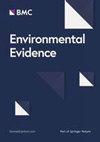减少草食性野生鸟类和哺乳动物对农作物损害的干预措施效果如何?系统评价方案
IF 5.2
4区 环境科学与生态学
Q2 ENVIRONMENTAL SCIENCES
引用次数: 0
摘要
减轻野生鸟类和哺乳动物对人类活动和生计,尤其是对农作物的负面影响是一个重要的保护挑战。限制损害数量和严重程度的技术干预是可用的,但对干预效果的评估通常在范围上有限,而且荟萃分析很少。本协议描述了一项系统综述,旨在回答以下问题:评估干预措施在减少草食性野生鸟类和哺乳动物对农作物的损害方面的效果如何?方法在Scopus和Zoological Record数据库中进行文献检索。搜索字符串基于种群-干预-比较者-结果(PICO)格式的研究问题,搜索词分为五类:野生动物类型(种群)、损害对象(种群)、对抗(干预)、评估(比较者)和损害(结果)。初始范围搜索通知了搜索字符串的修改。使用一组19篇基准文章来估计范围搜索捕获相关文献的能力。为了符合纳入综述的条件,原创文章应该研究干预措施暴露环境(为减少陆生鸟类和哺乳动物对农作物造成的损害而实施的措施)与没有干预措施暴露的对照环境进行比较的案例。符合条件的研究将进行数据提取,系统地记录在Excel电子表格中。将根据七个标准对纳入文章的相关偏倚风险进行严格评估:1。混淆偏差的风险,2。2 .干预后选择偏差风险;错误分类比较偏倚的风险(仅限观察性研究),3。4 .表现偏差风险(仅限实验研究);检测偏差风险,6。结果报告偏倚的风险;结果评估偏差的风险。研究结果将以叙述性的方式报告,如果可能的话,还将以定量综合的方式报告。定量综合将包括根据每项研究的数据计算出的汇总统计数据,并在森林图中图解说明。如有可能,将进行meta回归分析。本文章由计算机程序翻译,如有差异,请以英文原文为准。
How effective are interventions to reduce damage to agricultural crops from herbivorous wild birds and mammals? A systematic review protocol
Abstract Background An important conservation challenge is to mitigate negative impacts that wild birds and mammals can have on human practices and livelihoods, and not least on agricultural crops. Technical interventions to limit the number and severity of damages are available, but evaluations of intervention effectiveness are usually limited in scope, and meta-analyses are rare. This protocol describes a systematic review that seeks to answer the following question: How effective are evaluated interventions in reducing damage from herbivorous wild birds and mammals on agricultural crops? Methods The literature searches are made in the databases Scopus and Zoological Record. The search string is based on a Population-Intervention-Comparator-Outcome (PICO) formatted research question, and search terms fall within five categories: Wildlife type (Population), Damage object (Population), Counteraction (Intervention), Evaluation (Comparator), and Damage (Outcome). Initial scoping searches informed amendment of the search string. A set of 19 benchmark articles were used to estimate the ability of the scoping search to capture relevant literature. To be eligible for inclusion in the review, original articles should study cases where settings of exposure to interventions (measures implemented to reduce damages on agricultural crops caused by terrestrial birds and mammals) are compared to a control setting without exposure to interventions. Eligible studies will be subject to data extraction, systematically documented in an Excel spreadsheet. Associated risk of bias will be critically appraised for the included articles according to seven criteria: 1. risk of confounding biases, 2. risk of post-intervention selection biases, 3. risk of misclassified comparison biases (observational studies only), 4. risk of performance biases (experimental studies only), 5. risk of detection biases, 6. risk of outcome reporting biases, and 7. risk of outcome assessment biases. The results will be reported in narrative and, if possible, quantitative syntheses. The quantitative synthesis will include a summary statistic calculated based on the data of each study and illustrated graphically in a forest plot. If possible, meta-regression analyses will be conducted.
求助全文
通过发布文献求助,成功后即可免费获取论文全文。
去求助
来源期刊

Environmental Evidence
Environmental Science-Management, Monitoring, Policy and Law
CiteScore
6.10
自引率
18.20%
发文量
36
审稿时长
17 weeks
期刊介绍:
Environmental Evidence is the journal of the Collaboration for Environmental Evidence (CEE). The Journal facilitates rapid publication of evidence syntheses, in the form of Systematic Reviews and Maps conducted to CEE Guidelines and Standards. We focus on the effectiveness of environmental management interventions and the impact of human activities on the environment. Our scope covers all forms of environmental management and human impacts and therefore spans the natural and social sciences. Subjects include water security, agriculture, food security, forestry, fisheries, natural resource management, biodiversity conservation, climate change, ecosystem services, pollution, invasive species, environment and human wellbeing, sustainable energy use, soil management, environmental legislation, environmental education.
 求助内容:
求助内容: 应助结果提醒方式:
应助结果提醒方式:


